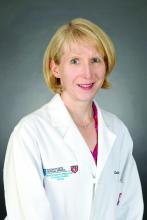At the 2018 annual meeting of the Society of Hospital Medicine – running from April 8 to 11 in Orlando – the theme could well be “in with the new, and in with the new.”
Planners for Hospital Medicine 2018 (HM18) have managed to pack the conference with five new tracks: Great Debate, Nurse Practitioner/Physician’s Assistant (NP/PA), Palliative Care, Seasoning Your Career, and a new Career Development workshop track. And they did this while eliminating only one track that was on the schedule last year – technology – and without adding any extra days to the meeting.
The trick was including more half-day tracks. With more tracks in smaller time chunks, the schedule provides more flexibility, and attendees have more choices to find what they’re looking for, said Kathleen Finn, MD, FHM, an assistant professor of medicine at Harvard Medical School, Boston, and the HM18 course director.
“We decided, since there were a bunch of themes that we really wanted to cover, we would do half-day tracks. The shorter tracks are also a way to gauge interest in a topic without making a big commitment to it,” Dr. Finn said. “The grouping of topics in smaller tracks in the Day-at-a-Glance helps people easily see a collection of lectures or a theme they might want to attend.”
While choosing themes for the meeting, the planners were trying to stay true to their own theme: timeliness.
“There’s pressure to make it a very relevant meeting,” Dr. Finn said. “We really want to have our finger on the pulse of what practicing hospitalists need and want to know and what is important to them. All the members of the committee feel very invested in figuring out: What is timely? What do we want to talk about right now? What are the active discussions and issues going on in health care that affect us in our practice?”
Assistant course director Dustin Smith, MD, FHM, an associate professor of medicine at Emory University, Atlanta, said much of the information for this year’s meeting came from the 2017 annual meeting, including attendance at sessions, speaker reviews, and session ratings.
“It’s building on momentum from the previous meeting,” he said. “Sometimes we choose things to offer that we know are going to go well, and sometimes we choose things that we hope go well, and all of a sudden we see [that they] go very, very well.” For instance, he said, the topic of sepsis was so popular last year that it has its own precourse this year.
The data on which the HM18 program is built doesn’t stop there. The 23 members of the planning committee – chosen strategically to represent a wide geographic range and array of practice types – all bring their own thoughts and experiences, as well as input from colleagues at their own centers. Then there are the submissions for workshop topics: Any SHM member can submit an idea, and – while just a few are chosen – those ideas help organizers see patterns of interest that can affect the planning of the rest of the sessions.
Here are more details on the new tracks:
Great debate
The annual meeting has traditionally had a “Great Debate” on perioperative medicine, but the format – with carefully chosen speakers who are dynamic and entertaining – will be used to cover pulmonary medicine and infectious diseases this year as well.
“It’s a hugely successful talk,” Dr. Finn said. “We can tell by our numbers that lots of people go, and it’s always funny, and it’s a very clever way of discussing the latest literature – by having two very dynamic speakers present a case and then debate the two options of the case and then use the literature to support the answer,” she said.
The hope is that the format will be more than just entertaining but will be an effective teaching tool, too.
“We think the high level of engagement and format of the talk leads to better overall education for those who attend,” Dr. Smith said.
NP/PA
This track includes topics chosen by the committee for advanced practice professionals.
“There are many hospitalist programs that include NP/PAs – this is what came through in all the feedback – and everybody is struggling with how do you best incorporate NPs and PAs into the group practice and have everybody work at the top of their license and work well together,” Dr. Finn said.
“The idea, too, is to be very inclusive of all providers and offering a track that focuses on NP/PAs but also includes physicians, physician leaders, and physician administrators,” Dr. Smith said. “It’s not designed for one type of practicing professional; it should be a good educational track for all.”
© Frontline Medical Communications 2018-2021. Reprinted with permission, all rights reserved.
